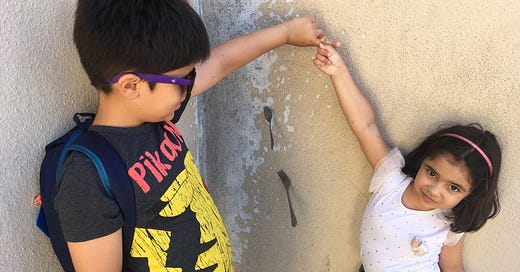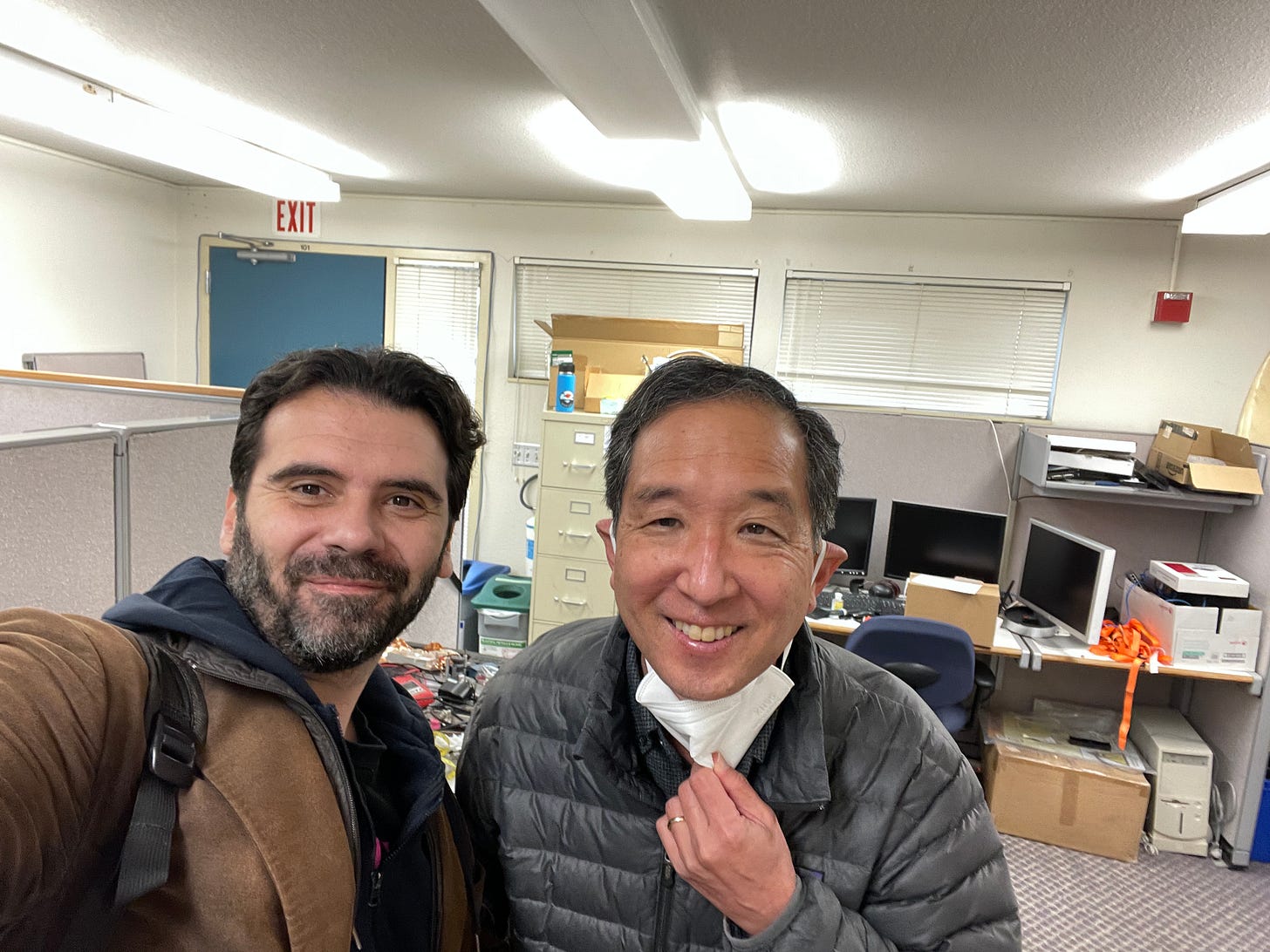A love letter to the Stanford MRSRL
Saying goodbye to a revolutionary MRI scanner and its famous Magnetic Wall
September 1997
“You should check out the Magnetic Wall!”
This was one of the first things I heard during the Stanford freshman orientation in 1997. The Magnetic Wall is considered by Reddit to be one of the fun “secret places” on the Stanford campus, but it is not a secret for any Stanford alumnus. Generations of students have thrown a metal part at the wall and watched it stick, wobble and precess. In 2019, it was the first place I showed my kids when we went to celebrate the 90th birthday of Al Macovski, the founder of the Magnetic Resonance Systems Research Lab (MRSRL) and the Magnetic Wall. Below is a personal history that reaches a bittersweet conclusion today when the MRSRL scanner will be celebrated and then decommissioned.
May 1998
I finally find out what the Magnetic Wall is about! It is the home of an MRI scanner! As many discoveries, it comes on unexpectedly and from leftfield. Professor Charlie Marcus gives the prospective physics majors a most unique E&M final exam. He tells us to write about a topic that we find personally interesting, and NMR/MRI is one of the ten suggestions. I choose MRI, and even though he tells us not to go over 5 pages for God’s sake, I end up writing ten pages (students, do NOT do this!) I write about Bloch and Purcell, and use cgs units to describe superconducting phenomena. I discover that Stanford has played a critical role in this story, and finish my report with: “What is outlined here are just the most basic physical principles underlying MRI. The rest was beyond my power of understanding.”
September 2003
I wish I could say that the 1998 final exam is the moment when I became obsessed with MRI, but that is not my personality. I take my time with everything, including career choices. For five years I precess around that Magnetic Wall, first thinking I will be a physics major, then (thanks to Brad Osgood) deciding to switch to electrical engineering, then taking and teaching all kinds of EE classes, but never meeting any MRI researchers.
It isn’t until the fall of 2003 that I become the EE graduate student advisor, and John Pauly happens to sit down at my lunch table during the EE student orientation. He is a new EE professor, and there’s something about him that makes me want to be his teaching assistant. I ask Marianne Marx (the legendary EE course coordinator) to make me a TA for EE102a, the introductory signals and systems class. I get the TA job and get to watch John struggle with his first lectures. With each subsequent lecture the awkwardness fades and I realize that I am in the presence of a walking encyclopedia of human knowledge. I ask him if he would be willing to be my PhD supervisor, even though I haven’t passed the notorious EE quals. He agrees and opens the door to the Magnetic Resonance Systems Research Lab (MRSRL) to me1.
2004 - 2009
Behind that door is a treasure, an MRI scanner from 1989 that somehow manages to look even more ancient than that. In the subsequent years I take Dwight Nishimura’s imaging classes, Brian Hargreaves’ EPIC course, and slowly start to understand the magic of the Magnetic Wall. I dare to scan alone, because you are not a true MR engineer unless you can operate a scanner at 3am in conditions that stretch the limits of IRB approval. I become the scanner’s safety officer2, even if that means dealing with complaints from neighboring buildings that the magnetic field is making their monitors fuzzy (likely), as well as their researcher’s heads (unlikely)3. I do weekly checks of the cold head and helium levels and wonder if this scanner burns helium faster than the sun can make it. And I perform cryogen fills (without any GE oversight), where I obsessively recite the steps inside my head (I am notoriously bad at following directions), and imagine dreadful quench scenarios. None of these scenarios materialize and I become more and more confident around machinery. Even today, whenever I get scared to drive a car (and it is my biggest fear), I remind myself that I used to drive an MRI scanner, and I did its plumbing too.
August 2019
Ten years after my PhD, I bring my family to Stanford to celebrate Al Macovski’s birthday! In preparing the MRM Highlights special issue celebrating his life (thank you Graham Wright!), I gain a deeper understanding of how crucial Al Macovski is to my research philosophy. Shiny new things do not change the world. What truly made an impact was not this ancient GE Signa 1.5T, but the culture of MRSRL and the hundreds of people who infused it with ingenuity, civility and altruism. As a new professor, I take Al’s words to heart: “Find good people and get out of their way!”
December 2022
I return to Stanford after a grueling pandemic. It is December 22, I wonder the empty campus with my family and decide to check out the scanner for which I still have the key (best $10 deposit I have ever made). I run into Dwight4, and he is changing the cryogen at MRSRL! We share a very special post-pandemic moment together and all is right with the world.
August 3, 2024
Knowing I cannot be at Stanford for the MRSRL scanner commemoration, I come to campus for a day, and sneak into the scanner for one last ride in the driving seat. It looks like nothing has changed, but then I do notice something new! A picture of all the MRSRL alumni, hanging in the corner of the console room. I feel immense pride to be on that picture!
August 30, 2024
I am teaching a class in Montreal on Friday afternoon, so I cannot make it in time for tomorrow’s MRSRL scanner celebration at Stanford. I should be preparing my lecture, but instead here I am revisiting a very special relationship with the MRSRL. Even though I left in 2009, 15 years later I still feel the magnetic pull of that wall. As many of you know, I am very good at long-distance relationships, but you need new things to keep those relationships strong. A small piece of me will quench tomorrow, but I know it will be replaced by something equally special, because it has never been about the scanner. It was always about the people who threw something at a wall, and then tried to understand why it sticks.
All that to say: I love you MRSRL!
He also opens up a world of opportunities that I still reap 20 years later. John stood by me when I failed the quals (I was the first person below the cutoff). He stood by me when I decided not to write that first paper. He stood by me when my girlfriend (now wife) was rejected three times for a US visa. Here is what I wrote about John in my PhD thesis acknowledgement in 2009 and I still stand by every single word.
John’s advice: “Appear responsive!”













That was one beautiful way to say farewell to a machine. But, of course it is not about the machine so much, but about the people which made it come alive.
You have a talent for writing, in addition to your other talents. Keep writing, and we'll keep reading.